- what is a material moisture?
- control of temperature indication reliability
- choosing a weighting dryer
- drying parameters
- preparing samples for drying
- example drying parameters settings
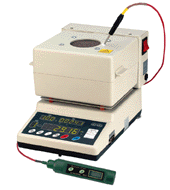
|
 |
Materials’ moisture is one of criteria deciding about substance quality. In many cases determining moisture has to be performed quickly and in the most reliable way. It concerns all laboratories and research centres connected directly with production. Using in such cases a traditional method which is based on weighing, drying for few hours in a stove and again weighing is impossible. Time needed for determining moisture using such method is too long. An ideal device allowing on taking a quick and accurate moisture measurement is then a weighting dryer. In the weighting dryers just like in a traditional method a thermogravimetry effect is used.
Thermogravimetry - is a process which determines mass loss the appears during substance heating. During such process a sample is weighted before and after heating and then a difference is calculated from those two specified weights. The name is derives from a Latin three part name:
thermo = heat, gravi = weight, meters = method
Material moisture is a set of all components that appear in a sample that evaporate during a process of its heating. It leads to mass decline. The majority of users do not notice a difference between moisture and water content in a sample. In the thermogravimetry methods (also a weighting dryer) all changing components evaporate during sample heating process. So moisture content is not only water evaporation but also fats, oils, alcohol, organic solvents, spices, and other elements that can be created as a result of a thermal break down (burning products). Total loss of all elements results in effect in mass decline. The difference in masses before and after drying allows on determining moisture. There is no possibility of selecting only pure water loss from loss of other elements.
There are many methods of determining moisture content in materials. Generally it is possible to divide those methods in two categories: absolute moisture defining and deductive moisture defining. Applying the absolute methods the moisture contents is marked directly i.e. as a proportion of mass before drying to mass after drying. In case of deduction methods the moisture content is marked directly. The physical properties are measured that are associated with humidity in a studied substance (i. e. electromagnetic rays absorption or electrical conductivity).
A weighting dryer consists of a precise laboratory scale and a drying chamber connected to it, which assures stable drying temperature during the measurement. Such construction causes for a relative humidity measurement to differ from a method acknowledged as a traditional one.
A new weighting dryers’ element is an outside thermometer PT 101 which fulfils a control function. It is a perfect solution for those users that have to exactly control drying temperature’s course.
The thermometer’s measurement element is a resistor temperature sensor PT 1000 of 12 cm in length that which has a stainless steel casing of 3 mm in diameter.
The sensor is connected with a reading head using a cable of about 1m in length of average mechanical resistance.
An additional function of this thermometer is a possibility of drying material temperature measurement. For substances dark in colors during drying appears an effect of heat consumption. It leads to unintentional temperature rise of a dried sample.
The moisture result then may not necessarily reflect the actual state. Basing on a difference between a set temperature and a real temperature (measured with a control thermometer) can determine a drying temperature correction coefficient.
Correction coefficient = (T measured - T set) / T set
where:
For every produced weighting dryer at present there can be a thermometer attached which is an additional equipment.
A weighting dryer being a universal work tool connects in itself two functions:
When deciding to purchase a certain type of a weighting dryer it is essential to know scope of work that are going to be preformed using the device.
If the weighting dryer is going to realize only drying process it is sufficient usually to have small maximum load scale i. e. 30g for WPS 30S. When stating moisture content usually small amount of applied load is used. It is possible then to not use a calibration weight since for humidity calculations proportion is important: in case of material drying need in very high temperature there is a special version of a weighting dryer that posses such possibility (drying up to 250°C), in case of an additional weighting dryer usage as a scale it is necessary to have a calibration weight. It is used for scale calibrating, eliminating gravitation acceleration influence. The calibration should be performed if the outside conditions changed considerably i. e. temperature of about 5 -10°C or a weighting dryer was moved to another work place.
Scale calibration- it is a set of operations that set relations between a displayed value by a scale and a standard mass (calibration weight) that provide scale load and performing display corrections if such need occurs. A weighting dryer’s scope of weighting designed simultaneously for stating moisture and sample weighting should be big i.e. 110g for WPS 110S or 210g for WPS 210S.
One should definitely distinguish between a weighing and a drying function. The Measuring Office’s procedure concerning the weighting dryers’ legalization is limited to specifying scale errors of meteorological parameters.
All produced weighting dryers have the certifications of type issued by the President of GUM 887/98 (The Central Measuring Office) decision number 65/95 receiving marks RPT 9553. The legalization does not concern the errors in determining moisture that can be an effect of an incorrect drying method (sample preparation, not properly selected drying temperature etc.).
During a process of drying in order to obtain constant mass the process of determining moisture is finished when the 3 following results of dried mass sample will be the same. During drying in a provided time the process of assuming moisture ends when the set drying time passes.
The weighting dryer allows on stating moisture offering 7 different possibilities. Depending on the requirements one should before beginning drying choose one of them.
Mass of evaporated water
1. in[%] ----------------------------- x 100 %
Initial sample mass
Current sample mass
2. in[%] ----------------------------- x 100 %
Initial sample mass
Mass of evaporated water
3. in[%] ----------------------------- x 100 %
Final sample mass
Mass of evaporated water
4. in[%] ----------------------------- x 100 %
Initial sample mass
Current sample mass
5. in[%] ----------------------------- x 100 %
Initial sample mass
Mass of evaporated water
6. in[%] ----------------------------- x 100 %
Final sample mass
Mass of evaporated water
7. in[%] ----------------------------- x 100 %
Initial sample mass
A value depends on the type of material. Too low temperature results in partial water evaporating (sample not dry enough). Too high temperature results in material burning effect (sample overheating) or a possibility of other chemical reactions occurring. The drying temperature is provided in trade or in factory norms. If there are no norms they should be picked experimentally. The temperature often used is 104°C. It is a temperature which favors giving back free water contained in the sample.

The drying temperature using a traditional method “stove” given by the trade or factory norms. It is often too low for drying in the weighting dryer and its optimal value should be settled experimentally. The temperature value is set from a weighting dryer’s keyboard. It is automatically stabilized through a regulation set. The set scaling takes place in a factory in comparison to a point that lies approximately 1 mm above a middle of an empty scale pan. Because of the temperatures distribution in a drying chamber and the physical features of a studied material (sample layer thickness, sample color) this temperature may slightly differ from the real temperatures of a dried material.
It is a time interval given in seconds between the following dried sample mass measurements. It is a criterion based on which the weighting dryer assumes for the sample to be dried. The too short sampling time results in premature measurement finishing. The too long sampling time will result in oscillating around a final result. One should remember that the measurement ends when 3 following humidity measurements are the same. It practice it means that with a set sampling time to 2 sec. drying will be finished if for 6 sec. the same mass result is going to appear. If the sampling time is set to 20 sec. then through 1 minute the mass result must be unchangeable.
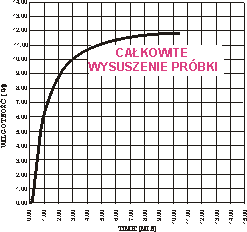
Correct choice of drying parameters
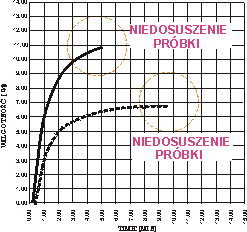
Too short sampling time, too low drying
temperature, too big sample mass
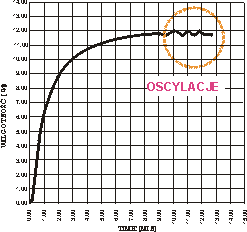
Disturbances in a drying process, too
long sampling time
A sample mass (depends on a material type) should be chosen in such way so a thin layer covers the scale pan. In case of materials that do not give back water easily the sample mass has a very big influence on a measurement result. Since humidity is an average measurement (recounted accordingly to mass indications) one should not use weights that are too small below 1 g. Weighing and at the same time drying of such small masses can be burdened with exaggerated relative error.


In order to obtain constant mass in case of drying the measurement endurance time depends on choosing the drying parameters such as sampling time, drying temperature and the sample size. In case of drying in a set time of the measurement endurance is specified by a user.
When preparing a sample for humidity measurement one should pay attention to few facts. If not paying enough attention to this phase of preparation work it is possible to at the beginning of the drying process to have a sample of false moisture.
If the sample is to be reduced (i. e. ground) before drying it should be prepared in such way so it does not generate heat. It should be remembered that the heat generated in a process of preliminary processing causes partial moisture loss before an appropriate drying.
A source from which a sample will be extracted and prepared plays a very important role in and credibility repetitiveness of the results. After sample extraction it should represent the analyzed product as a whole.
In the majority of cases the product can be homogenized by mixing or stirring before sample taking. It is also common to take few samples from different product parts or from defined intervals and calculating an average from the obtained values. A different way to be sure that the sample is reflects the product is mixing few samples extracted from different areas of the product. Which one of the mentioned above is most effective for individual usage depends on the requirements of the analysis performed.
When the sample is being extracted and later on prepared it is important that it does not loose moisture as a results of the outside conditions’ influence. Therefore the sample should be extracted and prepared as quickly as it is possible. It is recommended that only one sample is prepared at a time.
Extracting few samples simultaneously requires preparing hermetically sealed containers (desiccators). The samples that are before drying will stay in them. However one should make sure that the containment conditions do not interfere with sample status or conditions. Hot substances loose moisture very fast. If they are being kept in a wrapping, moisture can condense on a container’s walls. Before analyzing such a sample the condensed moisture must be stirred back into the sample. If the condensed moisture is not stirred back into the sample a value measured by a weighting dryer will be too low. The wrapping’s overall dimensions have to be adequate for the number of samples. If the wrapping is too big and not completely filled then the sample can change its moisture.
All of the materials that we specify humidity for can be divided to 3 groups:
Each one of the mentioned above materials is characterized by different work method. It consists of few factors such as:
Depending on a structure of a solid body (compact, loose) a process of defining humidity runs quicker or slower. The surface value of a solid body decides about the speed of drying and measurement accuracy. The surface of the solid body should be as big as possible. Because solids give back moisture by external surface sample thickness plays an important role.
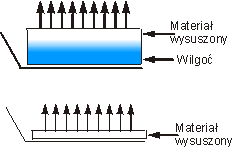
Dried are in natural form in which they occur or after grinding down. Grinding down the sample favors obtaining smaller dispersions between the following measurements. The sample’s mass cannot be too big. The sample should cover in thin layer the whole surface of a scale pan. The dark coloring materials absorb heat during the process of drying. The coefficients correcting the drying process should be determined for them.
The semi-fluid substances are dried in such form in which they exist. Big amounts of fat existing in some substances make the process of defining humidity much harder. In such cases additional elements should be used that increase sample’s active surface through which moisture is given away. Such elements include quartz sand, blotting paper. Before specific drying additional elements should be dried so that their humidity is close to zero.
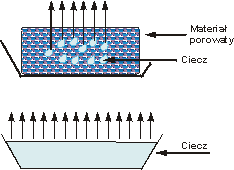
Standard element existing in a drying process is a scale pan. Made out of aluminum foil has 92 mm in diameter what provides a lot of space for free sample arranging.
Using the same scale pans for numerous dryings may result in leaving pieces of a previously examined sample. If the scale pan has not been completely cleaned or if some of the cleaning agents stayed on it, it may result in receiving false results (uniqueness).
In order to obtain repeatable results one should use a sample thinly spread on the scale pan. The sample should be adjusted to the scale pan quickly enough so it does not loose its moisture before analysis. If the sample is placed randomly, insufficiently, unevenly then in result heat conducting to the dried substance is going to be uneven. As a result the sample will not be dried completely or the drying will extend in time unnecessarily.

If the sample is built unevenly on the scale pan then the upper layers receive more heat than the lower ones. The sample can burn or its surface can form a crust (impervious layer) which makes giving away moisture from the lowers parts impossible.

If we apply a very thin sample layer or a crust form on the sample’s surface then it would make it hard or even impossible to give away moisture.

A weighting dryer as every precise electronic scale one should put in a place where there is no vibrations and shielded from blasts of air. The temperature changes in a room where the weighting dryer works cannot be too big.
When taking a series of measurements it is recommended to reject 1 measurement because of the possibility of making an additional error resulted from not reaching stable temperature of the drying chamber.
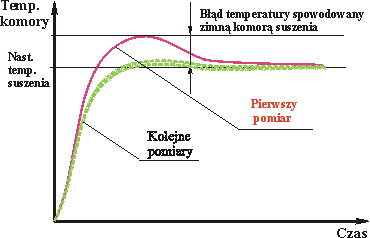
The weighting dryers WPS series determine a sample’s initial weight, which is necessary for judging the results only once with a cover lowered. All later calculations performed during the analysis are performed using this original value.
If sample placing on the scale pan takes too much time then part of the moisture evaporates from the sample before its analysis. As a result we receive a result informing about too low moisture content. This can raise doubts about correctness of the weighting dryer’s work. If the sample consists of highly volatile matter then it is recommended to place the sample on the scale pan outside of the chamber.
| MATERIAL | SAMPLE WEIGHT [g] | DRYING TEMPERATURE [°C] | SAMPLING TIME [s] | COMMENTS |
|---|---|---|---|---|
| Dried grain | 5-7 | 110 | 10 | Grind a sample |
| Semolina | 2 - 2,5 | 130 | 10 | Grind a sample |
| Wheat grain | 2 - 2,5 | 130 | 10 | Grind a sample |
| Barley grain | 2 - 2,5 | 130 | 10 | |
| Rock powder | 8 -10 | 160 | 15 | |
| Coffee | 2 | 150 | 10 | |
| Instant coffee | 5 | 10 | 150 | Grind a sample |
| Whole bean coffee | 3,5 - 4 | 120 | 15 | Grind a sample |
| Ground coffee | 2 - 3 | 106 | 5 | |
| Cocoa powder | 2,5 | 105 | 10 | |
| Cocoa grain | 4 -5 | 130 | 10 | Grind to fine powder |
| Limestone | 12 -14 | 160 | 10 | |
| Powdered coal | 4 | 160 | 10 | |
| Loess | 10 -15 | 160 | 15 | |
Low-fat powdered milk |
4 | 90 | 15 | |
| Melted and hard cheeses | 4 - 5 | 130 | 5 | Mix with sand |
| Whey concentrate | 2 -3 | 90 | 10 | |
| Whole milk | 5 | 110 | 15 | Mix a sample |
| Multivitamin | 3 -3,4 | 115 | 10 | Crush into a coarse-grained powder |
| Orange juice concentrate | 2 - 3 | 115 | 20 | Mix a sample |
| Quartz sand | 10 -14 | 160 | 10 | |
| Oily seeds | 3 - 4 | 90 | 15 | Grind a sample |
| Rice (boiled) | 3,5 | 105 | 10 | Grind a sample |
| Camay soap, white | 3 | 120 | 15 | Peel off the pieces |
| Sesame seeds | 3 | 130 | 20 | |
| Soya flour | approx. 4,6 | 95 | 10 | |
| Sunflower seeds | 3-3,5 | 100 | 15 | Grind a sample |
| Rape | 5 - 8 | 130 | 40 | Without breaking up |
| Starch glue | 1,5 | 100 | 20 | Intermix |
| Active carbon | 10 | 80 | 10 | |
| Cotton | 3 - 4 | 110 | 10 | Grind a sample |
| Pea | 3,5 | 135 | 10 | Grind a sample |
| Tobacco | 1,5 | 100 | 15 | Tear into small pieces |
| Textile material | 0,8 -1,2 | 85 | 10 | Withdraw the fibres |
| Dry yeast | 150-160 | 80 | 15 | Crush a sample |
| Dry apple pomace | 5 - 8 | 100 | 10 | Sample break up |
| Wet apple pomace | 5 - 8 | 100 | 10 | Sample break up |
| Butter | 2 - 5 | 138 | 15 | |
| Mustard | 2 - 3 | 130 | 20 | |
| Oat flakes | 2 - 4 | 120 | 15 | |
| Yoghurt | 2 - 3 | 110 | 15 | |
| Margarine | 3 - 4 | 138 | 20 | |
| Walnuts | 2,8 | 100 | 20 | Crush into a coarse-grained powder |
| Washing detergents | 2 | 160 | 15 | |
| Wheat flour | 6 | 130 | 10 | |
| Bran wheat | 4,0 | 150 | 10 | Grind a sample |
| Cellulose pulp | 2,5 | 130 | 20 | |
| Beet sugar | 2 | 110 | 20 |
 |
Distributed by : LAB-EL Laboratory Electronics 68b, Bodycha Str., 02-495 Warsaw tel: (022) 667 71 18, 0601 209656, fax: (022) 867 53 32 e mail: info@label.com.pl home page: http://www.label.com.pl internet meteorological station: http://www.meteo.waw.pl meteorological station on a mobile phone: wap.meteo.waw.pl Last updated: 22.11.2005 |
 |